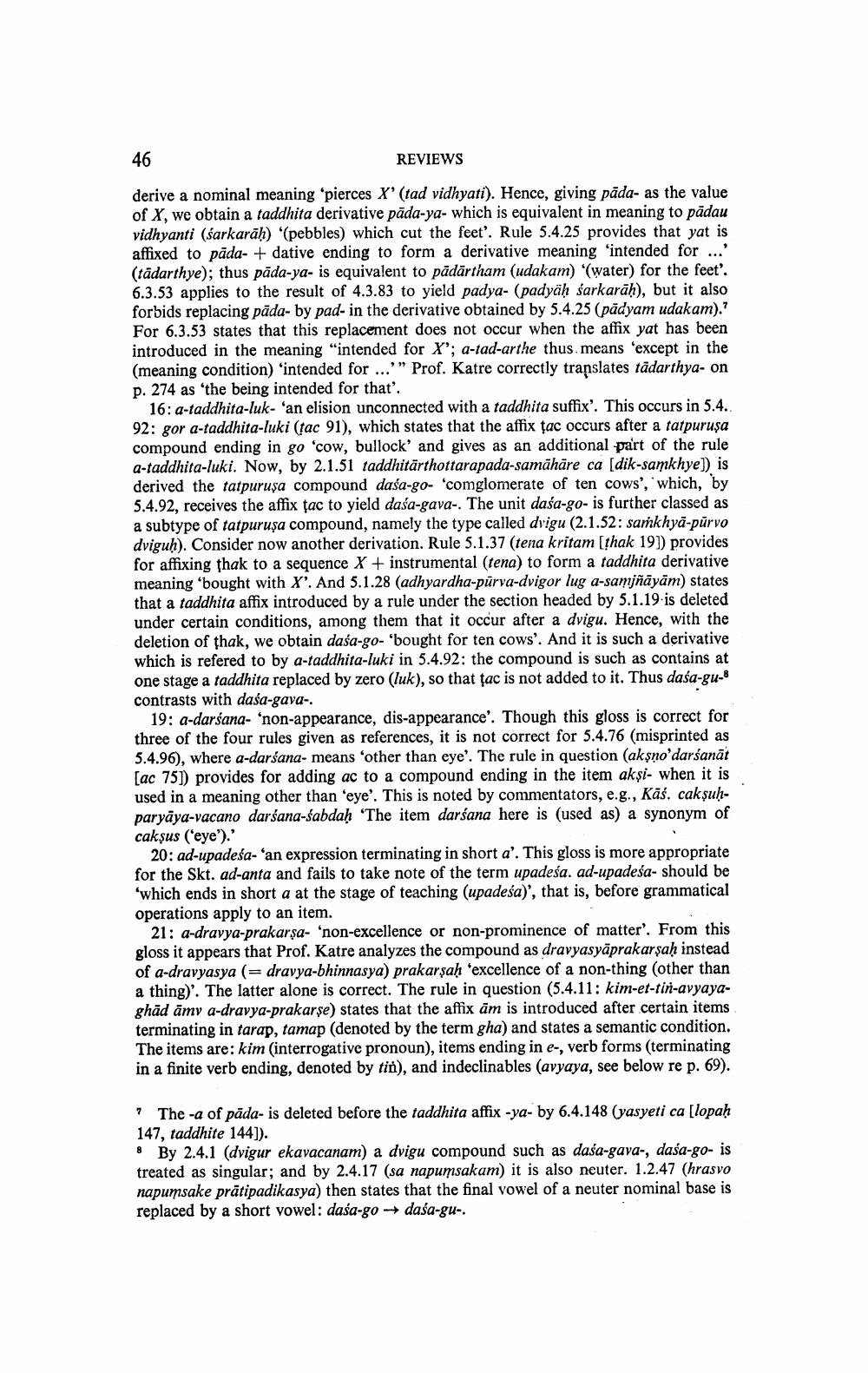Book Title: Reviews Of Different Books Author(s): Publisher: View full book textPage 4
________________ 46 REVIEWS derive a nominal meaning 'pierces X' (tad vidhyati). Hence, giving pada- as the value of X, we obtain a taddhita derivative pada-ya- which is equivalent in meaning to padau vidhyanti (sarkarah) '(pebbles) which cut the feet'. Rule 5.4.25 provides that yat is affixed to pada- + dative ending to form a derivative meaning 'intended for ...' (tadarthye); thus pada-ya- is equivalent to padartham (udakam) '(water) for the feet'. 6.3.53 applies to the result of 4.3.83 to yield padya- (padyah sarkara"), but it also forbids replacing pada- by pad- in the derivative obtained by 5.4.25 (padyam udakam).? For 6.3.53 states that this replacement does not occur when the affix yat has been introduced in the meaning "intended for X'; a-tad-arthe thus means 'except in the (meaning condition) 'intended for ...'" Prof. Katre correctly translates tadarthya-on p. 274 as 'the being intended for that. 16:a-taddhita-luk- 'an elision unconnected with a taddhita suffix'. This occurs in 5.4. 92: gor a-taddhita-luki (tac 91), which states that the affix tac occurs after a tatpurusa compound ending in go 'cow, bullock' and gives as an additional part of the rule a-taddhita-luki. Now, by 2.1.51 taddhitarthottarapada-samahare ca [dik-samkhye]) is derived the tatpurusa compound dasa-go- 'comglomerate of ten cows', which, by 5.4.92, receives the affix tac to yield dasa-gava-. The unit dasa-go- is further classed as a subtype of tatpurusa compound, namely the type called dvigu (2.1.52: samkhya-purvo dviguh). Consider now another derivation. Rule 5.1.37 (tena kritam (thak 19]) provides for affixing thak to a sequence X + instrumental (tena) to form a taddhita derivative meaning 'bought with X'. And 5.1.28 (adhyardha-purva-dvigor lug a-samjnayam) states that a taddhita affix introduced by a rule under the section headed by 5.1.19 is deleted under certain conditions, among them that it occur after a dvigu. Hence, with the deletion of thak, we obtain dasa-go- 'bought for ten cows'. And it is such a derivative which is refered to by a-taddhita-luki in 5.4.92: the compound is such as contains at one stage a taddhita replaced by zero (luk), so that tac is not added to it. Thus dasa-gu-8 contrasts with dasa-gaya-. 19: a-darsana- 'non-appearance, dis-appearance'. Though this gloss is correct for three of the four rules given as references, it is not correct for 5.4.76 (misprinted as 5.4.96), where a-darsana- means 'other than eye'. The rule in question (aksno'darsanat [ac 75]) provides for adding ac to a compound ending in the item aksi- when it is used in a meaning other than 'eye'. This is noted by commentators, e.g., Kas. caksuhparyaya-vacano darsana-sabdah "The item darsana here is (used as) a synonym of caksus ('eye').' 20: ad-upadesa-'an expression terminating in short a'. This gloss is more appropriate for the Skt. ad-anta and fails to take note of the term upadesa. ad-upadesa- should be 'which ends in short a at the stage of teaching (upadesa)', that is, before grammatical operations apply to an item. 21: a-dravya-prakarsa- 'non-excellence or non-prominence of matter'. From this gloss it appears that Prof. Katre analyzes the compound as dravyasyaprakarsah instead of a-dravyasya (=dravya-bhinnasya) prakarsah 'excellence of a non-thing (other than a thing)'. The latter alone is correct. The rule in question (5.4.11: kim-et-tin-avyayaghad amy a-dravya-prakarse) states that the affix am is introduced after certain items terminating in tarap, tamap (denoted by the term gha) and states a semantic condition. The items are: kim (interrogative pronoun), items ending in e-, verb forms (terminating in a finite verb ending, denoted by tin), and indeclinables (avyaya, see below re p. 69). 7 The -a of pada- is deleted before the taddhita affix -ya- by 6.4.148 (yasyeti ca [lopah 147, taddhite 144]). 8 By 2.4.1 (dvigur ekavacanam) a dvigu compound such as dasa-gava-, dasa-go- is treated as singular; and by 2.4.17 (sa napumsakam) it is also neuter. 1.2.47 (hrasvo napumsake pratipadikasya) then states that the final vowel of a neuter nominal base is replaced by a short vowel: dasa-go - dasa-gu-.Page Navigation
1 2 3 4 5 6 7 8 9 10 11 12 13 14 15 16 17 18 19 20 21 22 23 24 25 26 27 28 29 30 31 32 33 34 35 36 37 38
